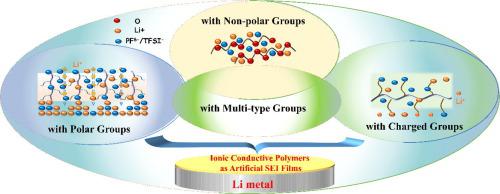当前位置:
X-MOL 学术
›
Mater. Today
›
论文详情
Our official English website, www.x-mol.net, welcomes your
feedback! (Note: you will need to create a separate account there.)
Ionic conductive polymers as artificial solid electrolyte interphase films in Li metal batteries – A review
Materials Today ( IF 21.1 ) Pub Date : 2020-11-01 , DOI: 10.1016/j.mattod.2020.06.011 Shilun Gao , Feiyuan Sun , Nian Liu , Huabin Yang , Peng-Fei Cao
Materials Today ( IF 21.1 ) Pub Date : 2020-11-01 , DOI: 10.1016/j.mattod.2020.06.011 Shilun Gao , Feiyuan Sun , Nian Liu , Huabin Yang , Peng-Fei Cao

|
Abstract Lithium (Li) metal has been considered as the ultimate anode material for next-generation rechargeable batteries due to its ultra-high theoretical specific capacity (3860 mAh g−1) and the lowest reduction voltage (−3.04 V vs the standard hydrogen electrode). However, the dendritic Li formation, uncontrolled interfacial reactions, and huge volume variations lead to unstable solid electrolyte interphase (SEI) layer, low Coulombic efficiency and hence short cycling lifetime. Designing artificial solid electrolyte interphase (artificial SEI) films on the Li metal electrode exhibits great potential to solve the aforementioned problems and enable Li–metal batteries with prolonged lifetime. Polymer materials with good ionic conductivity, superior processability and high flexibility are considered as ideal artificial SEI film materials. In this review, according to the ionic conductive groups, recent advances in polymeric artificial SEI films are summarized to afford a deep understanding of Li ion plating/stripping behavior and present design principles of high-performance artificial SEI films in achieving stable Li metal electrodes. Perspectives regarding to the future research directions of polymeric artificial SEI films for Li–metal electrode are also discussed. The insights and design principles of polymeric artificial SEI films gained in the current review will be definitely useful in achieving the Li–metal batteries with improved energy density, high safety and long cycling lifetime toward next-generation energy storage devices.
中文翻译:

离子导电聚合物作为锂金属电池中人造固体电解质界面膜——综述
摘要 锂 (Li) 金属因其超高的理论比容量(3860 mAh g-1)和最低的还原电压(-3.04 V vs 标准氢电极)而被认为是下一代可充电电池的终极负极材料。 )。然而,枝状锂的形成、不受控制的界面反应和巨大的体积变化导致不稳定的固体电解质界面(SEI)层、低库仑效率和短循环寿命。在锂金属电极上设计人工固体电解质中间相(人工SEI)膜在解决上述问题和延长锂金属电池寿命方面具有巨大潜力。具有良好的离子导电性、优越的加工性能和高柔韧性的聚合物材料被认为是理想的人造SEI薄膜材料。在这篇综述中,根据离子导电基团,总结了聚合物人工 SEI 膜的最新进展,以深入了解锂离子电镀/剥离行为,并提出高性能人工 SEI 膜在实现稳定锂金属电极方面的设计原则。还讨论了有关用于锂金属电极的聚合物人工 SEI 膜的未来研究方向的展望。在当前审查中获得的聚合物人工 SEI 膜的见解和设计原则对于实现具有更高能量密度、高安全性和长循环寿命的锂金属电池对下一代储能设备绝对有用。总结了聚合物人造 SEI 膜的最新进展,以深入了解锂离子电镀/剥离行为,并提出高性能人造 SEI 膜的设计原理,以实现稳定的锂金属电极。还讨论了有关用于锂金属电极的聚合物人工 SEI 膜的未来研究方向的展望。在当前审查中获得的聚合物人工 SEI 膜的见解和设计原则对于实现具有更高能量密度、高安全性和长循环寿命的锂金属电池对下一代储能设备绝对有用。总结了聚合物人造 SEI 膜的最新进展,以深入了解锂离子电镀/剥离行为,并提出高性能人造 SEI 膜的设计原理,以实现稳定的锂金属电极。还讨论了有关用于锂金属电极的聚合物人工 SEI 膜的未来研究方向的展望。在当前审查中获得的聚合物人工 SEI 膜的见解和设计原则对于实现具有更高能量密度、高安全性和长循环寿命的锂金属电池对下一代储能设备绝对有用。还讨论了有关用于锂金属电极的聚合物人工 SEI 膜的未来研究方向的展望。在当前审查中获得的聚合物人工 SEI 膜的见解和设计原则对于实现具有更高能量密度、高安全性和长循环寿命的锂金属电池对下一代储能设备绝对有用。还讨论了有关用于锂金属电极的聚合物人工 SEI 膜的未来研究方向的展望。在当前审查中获得的聚合物人工 SEI 膜的见解和设计原则对于实现具有更高能量密度、高安全性和长循环寿命的锂金属电池对下一代储能设备绝对有用。
更新日期:2020-11-01
中文翻译:

离子导电聚合物作为锂金属电池中人造固体电解质界面膜——综述
摘要 锂 (Li) 金属因其超高的理论比容量(3860 mAh g-1)和最低的还原电压(-3.04 V vs 标准氢电极)而被认为是下一代可充电电池的终极负极材料。 )。然而,枝状锂的形成、不受控制的界面反应和巨大的体积变化导致不稳定的固体电解质界面(SEI)层、低库仑效率和短循环寿命。在锂金属电极上设计人工固体电解质中间相(人工SEI)膜在解决上述问题和延长锂金属电池寿命方面具有巨大潜力。具有良好的离子导电性、优越的加工性能和高柔韧性的聚合物材料被认为是理想的人造SEI薄膜材料。在这篇综述中,根据离子导电基团,总结了聚合物人工 SEI 膜的最新进展,以深入了解锂离子电镀/剥离行为,并提出高性能人工 SEI 膜在实现稳定锂金属电极方面的设计原则。还讨论了有关用于锂金属电极的聚合物人工 SEI 膜的未来研究方向的展望。在当前审查中获得的聚合物人工 SEI 膜的见解和设计原则对于实现具有更高能量密度、高安全性和长循环寿命的锂金属电池对下一代储能设备绝对有用。总结了聚合物人造 SEI 膜的最新进展,以深入了解锂离子电镀/剥离行为,并提出高性能人造 SEI 膜的设计原理,以实现稳定的锂金属电极。还讨论了有关用于锂金属电极的聚合物人工 SEI 膜的未来研究方向的展望。在当前审查中获得的聚合物人工 SEI 膜的见解和设计原则对于实现具有更高能量密度、高安全性和长循环寿命的锂金属电池对下一代储能设备绝对有用。总结了聚合物人造 SEI 膜的最新进展,以深入了解锂离子电镀/剥离行为,并提出高性能人造 SEI 膜的设计原理,以实现稳定的锂金属电极。还讨论了有关用于锂金属电极的聚合物人工 SEI 膜的未来研究方向的展望。在当前审查中获得的聚合物人工 SEI 膜的见解和设计原则对于实现具有更高能量密度、高安全性和长循环寿命的锂金属电池对下一代储能设备绝对有用。还讨论了有关用于锂金属电极的聚合物人工 SEI 膜的未来研究方向的展望。在当前审查中获得的聚合物人工 SEI 膜的见解和设计原则对于实现具有更高能量密度、高安全性和长循环寿命的锂金属电池对下一代储能设备绝对有用。还讨论了有关用于锂金属电极的聚合物人工 SEI 膜的未来研究方向的展望。在当前审查中获得的聚合物人工 SEI 膜的见解和设计原则对于实现具有更高能量密度、高安全性和长循环寿命的锂金属电池对下一代储能设备绝对有用。











































 京公网安备 11010802027423号
京公网安备 11010802027423号